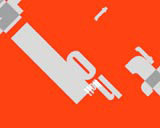Observe in-flight respite
Semiotic and typographic creations are dominating in-flight entertainment idents. Hannah Booth checks out the on-screen graphics in this rapidly expanding sector.

Designers are reaping the benefits of the burgeoning in-flight entertainment sector. As competition hots up between airlines, they are turning to design to up the branding stakes across their increasingly sophisticated channels. This lucrative source of design work is on the up.
Virgin Atlantic, Cathay Pacific, BMI and Airtours are launching on-screen idents next month for the channels on their long-haul flights. The rush of new work can, in part, be attributed to competitive prices attracting more passengers, the Internet making booking easier and more long-haul services hitting the market.
Hobbins Sides was appointed by BMI last November to create the on-screen identities for 20 channels on the carrier’s new transatlantic flights. The idents launch on 12 May on BMI’s inaugural long-haul flight from Manchester to Washington, followed shortly by flights to and from Chicago.
The consultancy was, unusually, brought in at an early stage, prior to the launch of Landor Associates’ identity for BMI in February. It was not shown the overall brand work-in-progress but was briefed by Landor to mirror the spirit of the new BMI brand with “speed with charm and style”.
Beyond this, Hobbins Sides’ brief was fairly open, says creative director Andrew Sides. The result is a series of six stylised, seven-second sequences designed to conjure up a sense of contemporary Britishness without resorting to overt jingoism or clichéd images of Britain’s heritage.
Designed to create a calming movement for passengers, each scenario features various objects, including a paper boat, a bicycle, a yo-yo, a boy playing with a toy taxi and a trout, as metaphors for relaxation. The images were selected because of their broad appeal and are randomly distributed across each channel.
“We wanted to lend the idents a contemporary British personality,” says Sides. He sought to reflect the sense of “Cool Britannia” creative Britishness, conveyed by individuals, such as singer Paul Weller and Terence Conran, he adds.
Each channel features a different shade of BMI’s corporate blue, which only the most regular passenger could use to identify each channel, and a set of basic graphics. The individual names, rather than the idents themselves, identify each channel. BMI did not want the idents to act as a conventional navigation system for passengers flicking between channels as it was too “obvious”.
Sides denies on-screen identity work plays second fiddle to other design work, such as cabin interiors, uniforms and the overall brand. “Television is as important a part of passengers’ experience as the seats, the in-flight magazine and the food,” he says.
BMI in-flight entertainment and communications manager Susan Bramley says on-screen design work of this type would normally be considered at a later date by airlines, but as BMI was rebranding, it was factored in early.
“It is important the transatlantic in-flight entertainment idents follow the guidelines created by Landor,” she says.
In contrast to BMI, Virgin Atlantic is rebranding its longhaul, in-flight entertainment idents to lend each channel its own identity. The existing channel names such as kids’ channel, Blast,Vent, the music channel and comedy channel Gas, were considered irrelevant, abstract and confusing.
Jump Design and Direction was appointed to rebrand Virgin’s 13 existing channels after a three-way pitch including Liquid, Component and Oasis. The idents launch on 1 May across all its transatlantic flights and long-hauls to New Delhi, Singapore and Tokyo.
Virgin had already created new channel names, including V.comedy and V.travel, and tasked Jump with creating clearer graphics that, in conjunction with the name, would provide passengers with a better idea of each channel’s output.
The idents are composed of ten-second animations featuring contrasting colours for each channel, alongside a series of relevant images reflecting the nature of each channel. For example, balloons and rockets are incorporated into the children’s channel’s ident, and the music channel features a graphic equaliser.
Jump senior designer Kate McNamara, responsible for the colouring of the sequences, says the consultancy tried to mirror the “contemporary, hip” Virgin brand values. “The idents are in line with the clean look of the current Virgin advertising to appeal to Virgin travellers,” she says.
McNamara claims the standard of in-flight entertainment has risen sharply since Virgin first introduced screens on the back of passengers’ seat to its long-haul flights. This has led to other airlines introducing the concept and using the channels as a further branding opportunity, she says.
Hong Kong carrier Cathay Pacific is undergoing a wide-ranging brand evaluation, part of which incorporates new on-screen idents by Kemistry.
Rolling out this month, the idents for Cathay’s 20 channels are designed to give a flavour of each, incorporating genre-specific icons. Each sequence starts with a generic opening, featuring a blue sky with clouds, which establishes the overall in-flight entertainment brand and its Be Inspired tagline, says Kemistry executive producer Richard Churchill.
As the camera pulls back, the sky is revealed to be a reflection in a droplet of water, which turns out to be one of many, each a different colour. This, says Churchill, suggests the number and variety of the channels. Inside each droplet are characters whose appearance, dress and gestures signify the mood and contents of each channel.
But it’s not just longhaul airlines that recognise the need for strong on-screen design and branding work. Kemistry is also designing channel idents for charter holiday airline, Airtours, which roll out in May.
“In-flight services are becoming points of differentiation between companies, particularly in the crowded package holiday market,” says Churchill. “And the design and architecture of the on-screen entertainment is becoming increasingly refined. On a plane, people will always watch a movie, if nothing else.”
-
Post a comment




